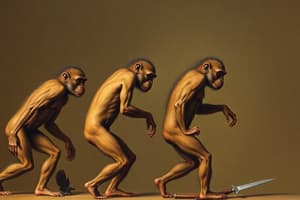Podcast
Questions and Answers
What is the primary focus of primatology within anthropology?
What is the primary focus of primatology within anthropology?
- Investigating the anatomy and physiology of primates.
- Understanding the social structures and behavior of primates.
- Studying the evolutionary connections between all primates, particularly the path leading to modern humans. (correct)
- Analyzing the ecological roles of primates in different ecosystems.
The study of primates helps anthropologists understand only the similarities between humans and other primates.
The study of primates helps anthropologists understand only the similarities between humans and other primates.
False (B)
What are two types of non-human primates that are most important for anthropologists to study?
What are two types of non-human primates that are most important for anthropologists to study?
Terrestrial primates and non-human apes
The study of primates, particularly those that live on the ground, helps us understand the adaptations of early human ancestors to a ______ environment.
The study of primates, particularly those that live on the ground, helps us understand the adaptations of early human ancestors to a ______ environment.
What type of evolutionary change is observed in the fossil record, leading to new species?
What type of evolutionary change is observed in the fossil record, leading to new species?
Match the following terms with their respective definitions:
Match the following terms with their respective definitions:
Homologous traits are evidence of shared ancestry between organisms.
Homologous traits are evidence of shared ancestry between organisms.
How do anthropologists determine macroevolutionary changes from the fossil record?
How do anthropologists determine macroevolutionary changes from the fossil record?
Which of the following traits was NOT selected for in primates, as a result of the mass extinction event 65 million years ago?
Which of the following traits was NOT selected for in primates, as a result of the mass extinction event 65 million years ago?
The mass extinction event that wiped out the dinosaurs was caused by a volcanic eruption.
The mass extinction event that wiped out the dinosaurs was caused by a volcanic eruption.
Early hominin ancestors were primarily arboreal, meaning they spent a significant amount of time in trees.
Early hominin ancestors were primarily arboreal, meaning they spent a significant amount of time in trees.
What are the two main methods used by anthropologists to determine the age of fossils?
What are the two main methods used by anthropologists to determine the age of fossils?
The ______ technique, which measures changes in radioactive isotopes, is commonly used for absolute dating of fossils.
The ______ technique, which measures changes in radioactive isotopes, is commonly used for absolute dating of fossils.
Which of the following environmental factors is NOT a direct cause of the evolution of bipedalism in early hominins?
Which of the following environmental factors is NOT a direct cause of the evolution of bipedalism in early hominins?
Anthropologists have discovered skeletal remains of nearly 6,000 early hominins, representing the entire hominin evolutionary history.
Anthropologists have discovered skeletal remains of nearly 6,000 early hominins, representing the entire hominin evolutionary history.
Which of the following is NOT a key evolutionary trend in primates?
Which of the following is NOT a key evolutionary trend in primates?
Name one specific technique used for absolute dating of hominin fossils found in volcanic layers.
Name one specific technique used for absolute dating of hominin fossils found in volcanic layers.
The study of human origins and evolution is known as ______.
The study of human origins and evolution is known as ______.
Match the following dating methods to their descriptions:
Match the following dating methods to their descriptions:
Fossils found in metamorphic rocks are relatively easy to date.
Fossils found in metamorphic rocks are relatively easy to date.
Which of the following methods is often used to date remains found in caves?
Which of the following methods is often used to date remains found in caves?
What is the primary challenge in defining species among fossil remains?
What is the primary challenge in defining species among fossil remains?
Anthropologists use shared ______ to define species in fossil remains.
Anthropologists use shared ______ to define species in fossil remains.
Which of the following is a derived trait used to classify fossils within the Homo genus?
Which of the following is a derived trait used to classify fossils within the Homo genus?
The grouping of fossils into species is always definitive and never changes.
The grouping of fossils into species is always definitive and never changes.
List the four evolutionary trends that define hominin evolution.
List the four evolutionary trends that define hominin evolution.
Match the following hominin traits with their evolutionary significance:
Match the following hominin traits with their evolutionary significance:
Which of the following species is believed to be the direct ancestor of Homo habilis?
Which of the following species is believed to be the direct ancestor of Homo habilis?
All hominins, including Australopithecus species, used Oldowan tools.
All hominins, including Australopithecus species, used Oldowan tools.
What evolutionary adaptation allowed Australopithecus africanus to evolve into Au. sediba?
What evolutionary adaptation allowed Australopithecus africanus to evolve into Au. sediba?
The emergence of the _____ genus is marked by increasing cranial capacity and more complex behavior.
The emergence of the _____ genus is marked by increasing cranial capacity and more complex behavior.
Which of these species is characterized by larger teeth and jaws, indicating a diet of harder vegetation?
Which of these species is characterized by larger teeth and jaws, indicating a diet of harder vegetation?
The earliest evidence of tool use among hominins was the production of Oldowan chopping tools.
The earliest evidence of tool use among hominins was the production of Oldowan chopping tools.
What is the name of the famous anthropologists who discovered Oldowan chopping tools?
What is the name of the famous anthropologists who discovered Oldowan chopping tools?
The _____ of animal protein and fats may have been a factor in the increase in cranial capacity among early hominins.
The _____ of animal protein and fats may have been a factor in the increase in cranial capacity among early hominins.
Match the following hominins with their dietary adaptations.
Match the following hominins with their dietary adaptations.
The term 'culture' can be applied to the tool-making behaviors of early hominins.
The term 'culture' can be applied to the tool-making behaviors of early hominins.
Describe the geological environment where the earliest known hominins, like Australopithecus afarensis, lived.
Describe the geological environment where the earliest known hominins, like Australopithecus afarensis, lived.
The use of Oldowan chopping tools indicates that early hominins relied on _____ innovations for environmental success.
The use of Oldowan chopping tools indicates that early hominins relied on _____ innovations for environmental success.
Which of the following is NOT a characteristic feature of Paranthropus robustus?
Which of the following is NOT a characteristic feature of Paranthropus robustus?
The evolutionary line leading to modern humans began with Homo habilis.
The evolutionary line leading to modern humans began with Homo habilis.
What is the name of the third evolutionary line that led to Homo habilis?
What is the name of the third evolutionary line that led to Homo habilis?
The Oldowan chopping tools were used primarily for ______, not hunting.
The Oldowan chopping tools were used primarily for ______, not hunting.
Which of the following hominins is considered a possible fourth evolutionary line, distinct from the Homo lineage?
Which of the following hominins is considered a possible fourth evolutionary line, distinct from the Homo lineage?
Flashcards
Primate Evolution
Primate Evolution
The process by which primates emerged and changed over time, leading to modern humans.
Primatology
Primatology
The study of primates with an emphasis on evolutionary connections relevant to humans.
Terrestrial Primates
Terrestrial Primates
Non-human primates that primarily live on the ground, important for understanding human ancestors.
Non-Human Apes
Non-Human Apes
Signup and view all the flashcards
Microevolution
Microevolution
Signup and view all the flashcards
Macroevolution
Macroevolution
Signup and view all the flashcards
Fossil Record
Fossil Record
Signup and view all the flashcards
Homologous Traits
Homologous Traits
Signup and view all the flashcards
Relative dating
Relative dating
Signup and view all the flashcards
Absolute dating
Absolute dating
Signup and view all the flashcards
Mass extinction event
Mass extinction event
Signup and view all the flashcards
Primate traits
Primate traits
Signup and view all the flashcards
Adapting to the environment
Adapting to the environment
Signup and view all the flashcards
Bipedalism
Bipedalism
Signup and view all the flashcards
Southern Kenya Rift Project
Southern Kenya Rift Project
Signup and view all the flashcards
Fossil scarcity
Fossil scarcity
Signup and view all the flashcards
Phylogenetic tree
Phylogenetic tree
Signup and view all the flashcards
Paleoanthropology
Paleoanthropology
Signup and view all the flashcards
Chemical dating techniques
Chemical dating techniques
Signup and view all the flashcards
Evolutionary advantage
Evolutionary advantage
Signup and view all the flashcards
Parental investment
Parental investment
Signup and view all the flashcards
Social networks in primates
Social networks in primates
Signup and view all the flashcards
Australopithecus africanus
Australopithecus africanus
Signup and view all the flashcards
Australopithecus sediba
Australopithecus sediba
Signup and view all the flashcards
Paranthropus boesei
Paranthropus boesei
Signup and view all the flashcards
Paranthropus robustus
Paranthropus robustus
Signup and view all the flashcards
Homo habilis
Homo habilis
Signup and view all the flashcards
Oldowan tools
Oldowan tools
Signup and view all the flashcards
Cranial capacity
Cranial capacity
Signup and view all the flashcards
Econiche
Econiche
Signup and view all the flashcards
Cultural innovations
Cultural innovations
Signup and view all the flashcards
Scavenging
Scavenging
Signup and view all the flashcards
Ecosystem adaptation
Ecosystem adaptation
Signup and view all the flashcards
Evolutionary path
Evolutionary path
Signup and view all the flashcards
Herbivorous diet
Herbivorous diet
Signup and view all the flashcards
Tool modification
Tool modification
Signup and view all the flashcards
Dating Fossils
Dating Fossils
Signup and view all the flashcards
Metamorphic Rocks
Metamorphic Rocks
Signup and view all the flashcards
Species Identity Challenges
Species Identity Challenges
Signup and view all the flashcards
Dental Changes
Dental Changes
Signup and view all the flashcards
Material Culture
Material Culture
Signup and view all the flashcards
Sahelanthropus tchadensis
Sahelanthropus tchadensis
Signup and view all the flashcards
Ardipithecus ramidus
Ardipithecus ramidus
Signup and view all the flashcards
Australopithecines
Australopithecines
Signup and view all the flashcards
Australopithecus afarensis
Australopithecus afarensis
Signup and view all the flashcards
Adaptive Advantage
Adaptive Advantage
Signup and view all the flashcards
Phylogenetic Position
Phylogenetic Position
Signup and view all the flashcards
Evolutionary Trends
Evolutionary Trends
Signup and view all the flashcards
Common Ancestor
Common Ancestor
Signup and view all the flashcards
Study Notes
Primate Evolution
- Primatology studies primates to understand human evolution, focusing on terrestrial primates and ape relatives.
- Studying primate adaptations, particularly those related to ground-dwelling, helps understand early human ancestors.
- Chimpanzees, gorillas, and other primates share traits with human ancestors, illustrating commonalities and evolutionary divergences.
- Microevolution involves short-term genetic changes within a species, unlike macroevolution which leads to new species over long periods.
- The fossil record is crucial for studying macroevolutionary changes in primates and hominins.
- Fossil dating utilizes relative and absolute methods (e.g., radiometric).
- Primate classification uses taxonomic groups, constantly updated based on new evidence.
- Primates emerged 65 million years ago, following a mass extinction event that cleared the way for mammal evolution.
- Key primate evolutionary traits include grasping ability, enhanced vision, hand/foot touch, larger brains, parental investment and sociality.
Hominin Evolution
- Early hominins likely originated in central-east Africa, in a drier, more open environment than their ancestors.
- Bipedalism was likely a crucial adaptation.
- Fossil evidence is limited and patchy, representing a fraction of hominin existence.
- Dating fossils relies on both relative (stratigraphy) and absolute (radiometric) techniques.
- Challenges arise in categorizing species based solely on physical traits.
- Fossil discoveries lead to refinements in hominin evolutionary timelines and models.
Four Hominin Evolutionary Trends
- Bipedalism: Walking on two legs
- Dental changes: Tooth size and jaw shape vary based on dietary adaptations
- Cranial capacity: Increased brain size relative to the body
- Material culture: Development of tools and other human-made objects
Directions of Early Hominin Evolution
- Early hominin ancestors shared a common lineage with chimpanzees.
- Early hominins like Sahelanthropus tchadensis and Orrorin tugensis are possible candidates for early members of the hominin line.
- Ardipithecus ramidus shows transitional traits for bipedalism, spending time in trees and on the ground.
- Australopithecines demonstrate more advanced bipedalism but retained some ape-like traits.
- Australopithecus afarensis, exemplified by "Lucy," was a successful hominin species inhabiting eastern Africa.
- Different populations of A. afarensis evolved into various species (e.g., africanus, sediba, robustus).
- Paranthropus species evolved to handle tougher vegetation and display marked dental and cranial robustness.
Homo habilis
-
The Homo genus, particularly H. habilis, experienced increased cranial capacity and potentially more complex behaviors.
-
Homo habilis is associated with the earliest known hominin tools, the Oldowan choppers.
-
These tools likely enabled these early hominins to scavenge on carcasses, access bone marrow which provided energy needed for bigger brains and possibly contribute to further cranial growth.
-
Other hominins besides Homo habilis (e.g., Australopithecus species) also used these early stone tools.
Studying That Suits You
Use AI to generate personalized quizzes and flashcards to suit your learning preferences.




